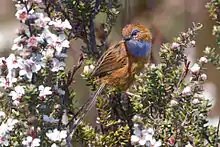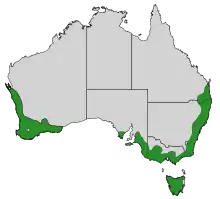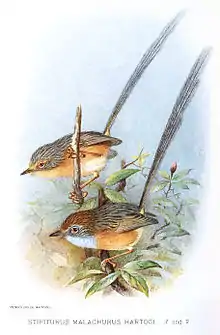Southern emu-wren
The southern emu-wren (Stipiturus malachurus) is a species of bird in the Australasian wren family, Maluridae. It is endemic to Australia. Its natural habitats are temperate forests and Mediterranean-type shrubby vegetation.
| Southern emu-wren | |
|---|---|
 | |
| Male in Tasmania | |
| Scientific classification | |
| Kingdom: | Animalia |
| Phylum: | Chordata |
| Class: | Aves |
| Order: | Passeriformes |
| Family: | Maluridae |
| Genus: | Stipiturus |
| Species: | S. malachurus |
| Binomial name | |
| Stipiturus malachurus (Shaw, 1798) | |
 | |
| Distribution map | |
| Synonyms | |
| |
Taxonomy and systematics

The southern emu-wren is one of three species of the genus Stipiturus, commonly known as emu-wrens, found across southern and central Australia. It was first characterized by naturalist George Shaw in 1798 as Muscicapa malachura, after being collected in the Port Jackson (Sydney) district.[2] It was described as the "soft-tailed flycatcher", native name mur-re-a-nera when painted between 1788 and 1797 by Thomas Watling, one of a group known collectively as the Port Jackson Painter.[3] Another painting in the same series yielded the indigenous name mereangeree.[4] Notes on this latter drawing suggest an alternate name of emu- or cassowary titmouse, from its soft tail feathers.[5] In the first description and illustration of the bird by Major-General Thomas Davies, another Sydney region indigenous name merion binnion was reported, since the tail resembled the "cassowary (emu)" feathers.[6]
The skin of a male southern emu-wren somehow ended up in the collection of Coenraad Jacob Temminck, who believed it to be from Java. From there it was named by François Levaillant as the gauze-tailed warbler. This mistake was not picked up for another 55 years.[5] Veillot defined the genus Malurus and placed the southern emu-wren within it, naming it as Malurus palustris.[5]
The southern emu-wren derives its common name from its tail feathers, the loosely barbed nature of which resembles feathers of the emu, the irony being that the emu-wrens are among the smallest of Australian birds, while the emu is the largest.[5]
Subspecies
Up to eleven subspecies have been described, with eight currently recognised:[7]
- S. m. malachurus - (Shaw, 1798): The nominate subspecies is found along the eastern coastline from Noosa Heads in Queensland south through New South Wales and Victoria and to the mouth of the Murray River in south-eastern South Australia. It remains east and south of the Great Dividing Range.[8]
- S. m. littleri - (Mathews, 1912): Found across Tasmania.[8]
- S. m. polionotum - (Schodde & Ian J. Mason, 1999): Found in south-central and south-eastern Australia
- S. m. intermedius - (Ashby, 1920): It is a darker-plumaged race from the Mount Lofty Ranges in South Australia.[8]
- S. m. halmaturinus - (Parsons, 1920): Found on Kangaroo Island. It is the largest race.[8]
- S. m. parimeda - (Schodde & Weatherly, 1981): Found on the southern tip of the Eyre Peninsula.[8] This subspecies is distinguishable from others by its significantly paler plumage.[9]
- S. m. westernensis - (Campbell, AJ, 1912): Originally described as a separate species. Found in south-western Western Australia.[8]
- S. m. hartogi - (Carter, 1916): It is restricted to Dirk Hartog Island.[8]
Description
The adult male has rusty-brown upperparts with streaks of black, the crown more reddish and grey-brown wings. It has a sky blue throat, upper chest and eyebrow. The tail is double the body length, and is composed of six filamentous feathers, the central two of which are longer than the lateral ones. The underparts are pale red-brown, paler on the belly. The bill is black and the feet and eyes are brown. The female is darker streaked and lacks the blue plumage and redder crown. Its bill is brown with a pale grey base.[10]
Distribution and habitat
Throughout its range, the southern emu-wren inhabits marshes, low heathland and dune areas.[11]
References
- BirdLife International (2016). "Stipiturus malachurus". IUCN Red List of Threatened Species. 2016: e.T22703772A93936110. doi:10.2305/IUCN.UK.2016-3.RLTS.T22703772A93936110.en.
- Rowley and Russell, p. 202.
- The Natural History Museum, London (2007). ""Soft-tailed Flycatcher", native name Mur-re-a-nera". First Fleet Artwork Collection. The Natural History Museum, London. Retrieved 3 September 2010.
- The Natural History Museum, London (2007). ""Soft-tailed Flycatcher", native name "Mereangeree"". First Fleet Artwork Collection. The Natural History Museum, London. Retrieved 3 September 2010.
- Hindwood, K.A. (1931). "Historical associations and early records of the Emu-wren". Emu. 31 (2): 99–110. doi:10.1071/mu931099.
- Davies, Thomas (6 February 1798). . Transactions of the Linnean Society. 4. London (published 1798). pp. 240–2.
- Gill, Frank; Donsker, David, eds. (2017). "Lyrebirds, scrubbirds, bowerbirds & Australasian wrens". World Bird List Version 7.3. International Ornithologists' Union. Retrieved 28 December 2017.
- Rowley and Russell, p. 204.
- "Stipiturus malachurus parimeda — Southern Emu-wren (Eyre Peninsula)". Department of Environment. 2013. Retrieved 20 March 2016.
- Rowley and Russell, p. 203.
- Rowley and Russell, p. 205.
cited text
- Rowley, Ian; Russell, Eleanor (1997). Bird Families of the World:Fairy-wrens and Grasswrens. Oxford: Oxford University Press. ISBN 0-19-854690-4.
